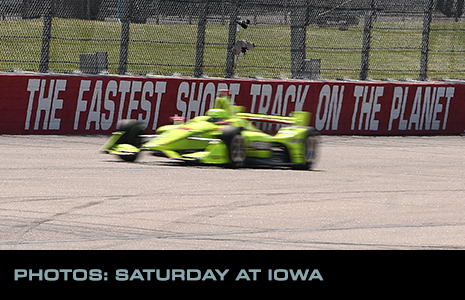Iowa Speedway track surface has some bumpy for race
JUL 07, 2018
NEWTON, Iowa – Not long ago, the bump over the tunnel at Iowa Speedway was the topic of concern among drivers. It’s not alone anymore.
Drivers talked about numerous bumps Saturday – especially in Turns 3 and 4 – and a slick surface around the 0.894-mile oval after Team Penske’s Will Power and Josef Newgarden swept the front row in qualifications for the start of Sunday’s Iowa Corn 300.
“The (tunnel bump) is actually not as bad now as it was the first three years, and I crashed there every year,” said Tony Kanaan, who qualified the No. 14 ABC Supply AJ Foyt Racing Chevrolet 13th in the 22-car field. “It’s actually in Turns 3 and 4 now. … Don’t take that the wrong way. It’s an awesome track and we need to come here every year, but it’s something we have to put up with. It’s not a complaint, it’s just a characteristic of the track.”
When asked about conditions after qualifying 15th, Sebastien Bourdais was blunt. “It’s not fun,” the No. 18 Team SealMaster Honda driver said.
When asked if other drivers felt the same, Bourdais said, “I don’t know. Ask them.”
Some drivers said the weathering of the track, which hosted its first Verizon IndyCar Series race in 2007, adds to its character. Others think the increase in bumpiness is unnerving.
“It’s super bumpy,” said Schmidt Peterson Motorsports rookie Robert Wickens, who called Iowa Speedway “the most foreign track I've ever driven in my entire life” after a test session June 28. “The track is unique. I thought I kind of understood the whole oval game, but coming here is entirely different. It’s been probably the steepest learning curve that I’ve had to do this year.”
It’s made more difficult for first-timers by a universal aero kit introduced this season. The kit, which is fitted to the existing Dallara IR-12 chassis, reduces downforce and makes the cars more difficult to handle. Some drivers said the combination of a surface that’s becoming increasingly bumpy and a reduction in downforce make Iowa one of the most demanding tracks on the Verizon IndyCar Series schedule.
“This is the most physical track we go to,” said Newgarden, who will start second in the No. 1 Hitachi Team Penske Chevrolet. “It's the most constant. I mean, you're never resting. You have a short break on the backstretch for about three seconds, and that's what you get. And it's where you can make some adjustments, but you're always turning. It's very, very physical. At the end of the race, you normally are slammed up into the side of the car.”
The correlation between liking and not liking the track’s conditions could be seen through qualifying. Drivers who didn’t like it generally didn’t qualify well. Drivers who found the rougher, slicker surface endearing generally qualified well.
“It’s not really an issue,” said Simon Pagenaud, who will start fourth in the No. 22 Menards Team Penske Chevrolet when the green flag waves at approximately 2:40 p.m. ET. “I think it’s actually great. I’m on the other side of the fence. I think the tarmac being slicker is actually better for racing. If it’s grippy, it’s not as much down to talents and team effort and the research and development behind it.”
 Pagenaud and others noted that the track had developed two distinct grooves during Saturday’s morning practice session, and that they were lifting and sliding through the turns.
Pagenaud and others noted that the track had developed two distinct grooves during Saturday’s morning practice session, and that they were lifting and sliding through the turns.
“It’s a lot different with the way we’re driving these cars with the new aero kit and how much less downforce we have,” said Ed Carpenter, who qualified ninth in the No. 20 Fuzzy’s Vodka Ed Carpenter Racing Chevrolet. “I’m enjoying it.”
The combination of lifting, sliding and bumps led some to believe the race will offer more passing opportunities than in previous years.
“It allows you to run high, middle and low,” Pagenaud said. “That wasn’t the case before because we had too much grip. Now, because you are limited on grip, you go up higher (on the track). It creates opportunities for passing. I like the track as it is. It’s rough. It’s not easy. But so is Detroit, and we race really well there.”
Others pointed to two previous oval races with the new aero kit – at ISM Raceway near Phoenix and Texas Motor Speedway. Plenty of uncertainty made the rounds before both races, but both races turned out to be entertaining.
“Let’s see. We’ve had two oval races where people thought the racing was going to be bad, and it was actually pretty good racing,” said Alexander Rossi, who qualified fifth in the No. 27 NAPA AUTO PARTS Andretti Autosport Honda. “I think this one will race the best because there are two lanes.”
Ask any driver to describe Iowa Speedway in one word – or even one sentence – and you won’t get anything resembling brief.
“I just know it’s a bumpy, high-banked short track,” Wickens, driver of the No. 6 Lucas Oil SPM Honda, said with a laugh. “Everyone always told me, ‘Oh, you’re going to love Iowa. It’s amazing.’ I think they were thinking about how it was when it was super smooth and nice.
“It’s still fun. It’s unique. One of the things I like about INDYCAR is that you drive on so many unique and challenging circuits. Bumps are a scenario you face on a day-to-day basis in INDYCAR. You have to be able to cope with them and get better.”
The 22 drivers will get the chance to see how they cope in Sunday’s 300-lap event. Live coverage begins at 2 p.m. ET on NBCSN and the Advance Auto Parts INDYCAR Radio Network.






















